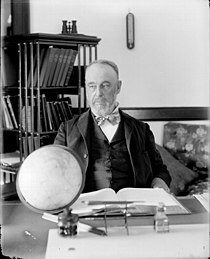Asaph Hall
Asaph Hall | |
|---|---|
 Asaph Hall at the USNO in 1899 | |
| Born | October 15, 1829 |
| Died | November 22, 1907 (aged 78) |
| Nationality | American |
| Alma mater | New-York Central College, McGrawville |
| Known for | Discovery of two Martian moons |
| Parent(s) | Asaph Hall II Hannah Palmer |
Asaph Hall III (October 15, 1829 – November 22, 1907) was an American astronomer who is most famous for having discovered the moons of Mars, Deimos and Phobos, in 1877.[1] He determined the orbits of satellites of other planets and of double stars, the rotation of Saturn, and the mass of Mars.
Life
Hall was born in Goshen, Connecticut, the son of Asaph Hall II (1800–42), a clockmaker, and Hannah Palmer (1804–80). His paternal grandfather Asaph Hall I (June 11, 1735 – Mar. 29, 1800) was a Revolutionary War officer and Connecticut state legislator.[2][3] His father died when he was 13, leaving the family in financial difficulty, so Hall left school at 16 to become an apprentice to a carpenter. He later enrolled at the Central College in McGrawville, New York, where he studied mathematics. There he took classes from an instructor of geometry and German, Angeline Stickney. In 1856 they married.
In 1856, Hall took a job at the Harvard College Observatory in Cambridge, Massachusetts, and turned out to be an expert computer of orbits. Hall became assistant astronomer at the US Naval Observatory in Washington DC in 1862, and within a year of his arrival he was made professor.
In 1875 Hall was given responsibility for the USNO 26-inch (66-cm) telescope, the largest refracting telescope in the world at the time. It was with this telescope that he discovered Phobos and Deimos in August 1877. Hall also noticed a white spot on Saturn which he used as a marker to ascertain the planet's rotational period. In 1884, Hall showed that the position of the elliptical orbit of Saturn's moon, Hyperion, was retrograding by about 20° per year. Hall also investigated stellar parallaxes and the positions of the stars in the Pleiades star cluster.
Hall was responsible for apprenticing Henry S. Pritchett at the Naval Observatory in 1875.

On June 5, 1872 Hall submitted an article entitled "On an Experimental Determination of Pi" to the journal Messenger of Mathematics. The article appeared in the 1873 edition of the journal, volume 2, pages 113–114. In this article Hall reported the results of an experiment in random sampling that Hall had persuaded his friend, Captain O.C. Fox, to perform when Fox was recuperating from a wound received at the Second Battle of Bull Run. The experiment involved repetitively throwing at random a fine steel wire onto a plane wooden surface ruled with equidistant parallel lines. Pi was computed as 2ml/an where m is the number of trials, l is the length of the steel wire, a is the distance between parallel lines, and n was the number of intersections. This paper, an experiment on the Buffon's needle problem, is a very early documented use of random sampling (which Nicholas Metropolis would name the Monte Carlo method during the Manhattan Project of World War II) in scientific inquiry.
Hall retired from the Navy in 1891. He became a lecturer in celestial mechanics at Harvard University in 1896, and continued to teach there until 1901.
The Halls had four children. Asaph Hall, Jr. (1859–1930) became an astronomer, Samuel Stickney Hall (1864–1936) worked for Mutual Life Insurance Company, Angelo Hall (1868–1922) became a Unitarian minister and professor of mathematics at the US Naval Academy, and Percival Hall (1872–1953) became president of Gallaudet University. Angeline Hall died in 1892. Hall married Mary Gauthier after he fully retired to Goshen, Connecticut in 1901.
Hall died in November 1907 while visiting his son Angelo in Annapolis, Maryland.
Awards and honors

Hall won the Lalande Prize of the French Academy of Sciences in 1878, the Gold Medal of the Royal Astronomical Society in 1879, the Arago Medal in 1893, and was made a Chevalier in the Ordre national de la Légion d'honneur (French Legion of Honor) in 1896.[4] Hall crater on the Moon as well as Hall crater on the Martian moon Phobos[5] are named in his honor. Asteroid 3299 Hall is also named in his honor.[citation needed]
References
- ^ Blunck, Jürgen (2009). "The Satellites of Mars; Discovering and Naming the Satellites". Solar System Moons: Discovery and Mythology. Springer. p. 5. ISBN 978-3-540-68852-5.
- ^ Connecticut Revolutionary War Lists, 1775–1783. p. 20.
- ^ Heads of families at the first U.S. census. Ct. By U.S. Bureau of the Census. Washington, 1908. (227p.): 45 Record of Conn. Men in mil. and naval service during the Rev. War, 1775–1783. By Henry P.Johnston. Hartford. 1889. (17,779p.): 61, 424, 548
- ^ Asaph Hall obituary by W.S. Eichelberger, published in Astronomische Nachrichten, 1908
- ^ "Phobos - Viking 1 Orbiter".
Further reading
- Angelo Hall. An Astronomer's Wife: The Biography of Angeline Hall. Baltimore: Nunn & Company, 1908. (This book is public domain in the United States; a full scan can be found at archive.org.)
- Percival Hall. Asaph Hall, Astronomer. Self-published, nd. (booklet, 46 pp.)
- George William Hill. A Biographical Memoir of Asaph Hall, 1829–1907. Judd and Detwiler: Washington, DC, 1908. (This book is public domain in the United States; a full scan can be found at archive.org.)
External links
- The History of the Detroit Observatory at www.umich.edu
- Washington DC anecdotes
- Mrs. Hall's bio
- Asaph Hall's gravestone
- National Academy of Sciences Biographical Memoir
